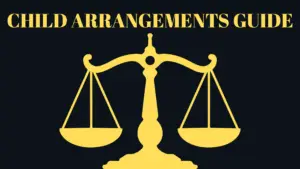Moving House with a Child Arrangements Order: A Father’s Guide to Relocation
“Last Updated” Date: Sunday, 12 October 2025
Whether it’s for a new job, a new partner, or to be closer to family, the need to move house is a normal part of life. But when a Child Arrangements Order is in place, that simple act becomes a complex legal minefield. The fear of being seen as obstructive, or worse, of accidentally breaking a court order, can cause immense stress, and you may feel that you have been subjected to significant emotional discomfort.
You need to understand this critical point: you cannot simply move a significant distance without the other parent’s consent or the court’s permission, as it impacts the order. This guide provides the authoritative, strategic roadmap for fathers navigating relocation. It explains the legal tests, the practical steps for applying to the court, and the crucial difference between moving within the UK and moving abroad, ensuring you build the strongest possible case based on your child’s best interests.
Key Takeaways
- Permission is Required: You must have the written consent of the other parent or permission from the court to relocate with your child if it significantly impacts the arrangements in the court order. Moving without it can have severe consequences.
- Internal vs. International is Crucial: The legal test is different for moving within the UK versus moving abroad (‘Leave to Remove’), with international relocation facing a much higher bar.
- The Welfare Checklist is Paramount: The judge’s decision will be based solely on what is in your child’s best interests, as defined by the seven factors in the Welfare Checklist. Your reasons for moving come second.
- A Solid Contact Plan is Essential: Your application must include a detailed, realistic, and well-researched plan for how the child will maintain a meaningful relationship with the other parent post-move.
Want one-to-one guidance on this? Message us now on WhatsApp.
Jump To
- A Deep Dive: The Law on Internal vs. International Relocation
- Your Strategic Path: The 4-Step Application Process
- At a Glance: Internal Relocation vs. International Relocation
- Common Mistakes That Weaken a Relocation Application
- FAQs about Relocating with a Child Arrangements Order
As a former Cafcass and Children’s Services Social Worker who wrote Section 7 reports for the court, the first thing I looked for in a relocation case was the motivation and the quality of the planning. A judge will quickly see through an application designed to frustrate contact. Your case must be built on a genuine reason for the move and a rock-solid, child-focused plan for maintaining the other parent’s relationship.
A Deep Dive: The Law on Internal vs. International Relocation
Internal Relocation (Within the UK)
There is no specific law that prevents you from moving house within England and Wales. However, if you have a Child Arrangements Order, and the move is significant enough to make the terms of that order unworkable, you must seek to vary it by agreement or by application to the court. The court’s decision will be based on the child’s best interests, as determined by the Welfare Checklist.
What This Means For You: A short move across town might not require a court application. A move from London to Manchester almost certainly will. The key consideration for the judge will be the impact on the child’s relationship with the other parent and whether your proposed new contact arrangements are realistic and in the child’s best interests.
International Relocation (Leave to Remove)
Taking a child to live permanently in another country is a far more serious step, legally known as “Leave to Remove.” You absolutely cannot do this without the written consent of everyone with Parental Responsibility or a specific court order. The court will apply the Welfare Checklist
with intense scrutiny, and the bar for getting permission is very high.
What This Means For You: The court’s primary concern will be the devastating impact of the move on the child’s relationship with the parent left behind. You will need an exceptionally well-researched and compelling case, covering schools, healthcare, travel logistics, and a concrete plan for frequent and meaningful contact.
Example: Snippet from a Position Statement for a Relocation Application
This application is to vary the Child Arrangements Order of [Date] to permit me to relocate with our child, [Child’s Name], from London to Manchester.
The reason for this move is a significant and secure job offer which will improve our financial stability and allow me to work more flexible hours. The offer of employment and a draft contract is attached at Exhibit A.
I have researched and secured a school place for [Child’s Name] at a school rated ‘Outstanding’ by Ofsted (see prospectus at Exhibit B). The move will also bring us closer to my parents, who can provide consistent childcare support.
I have created a detailed proposed contact schedule, including travel arrangements and costs, to ensure [Child’s Name] continues to enjoy regular and meaningful contact with his mother. This move is in my child’s best interests, as it provides a more stable home environment while ensuring his relationship with his mother is fully supported.
A Real Life Scenario: Michael wanted to move with his son from Bristol to Edinburgh to be with his new partner. Before doing anything, he discussed it with his ex-partner. She objected. Michael then attended a MIAM and made a C100 application. He presented the court with a detailed plan, including research on schools in Edinburgh, a proposed schedule for contact (including flights for his son to visit Bristol once a month and for half of all school holidays), and a clear budget showing he could afford the travel costs. Because his plan was so thorough and child-focused, the court granted his application.
Your Strategic Path: The 4-Step Application Process
Whether moving across the country or across the world, the formal process for getting permission is the same. For a full breakdown, see our guide on how to apply to vary a child arrangements order.
- Discuss and Mediate: Your first legal and practical step is to seek the other parent’s written consent. If they refuse, you must (in most cases) attend a MIAM to show the court you have attempted to resolve the issue without litigation.
- Prepare a Watertight Case: This is the most critical step. Gather all your evidence: your job offer, details of the new house and school, information on the support network you’ll have, and, most importantly, a detailed, realistic, and funded plan for future contact with the other parent.
- File the C100 Application:
You must apply to the court using the C100 form. In your supporting statement, you will need to set out all the reasons for the move and explain how it is in your child’s best interests, using the Welfare Checklist as your guide. - Engage with the Court Process: The court will list a hearing (FHDRA) and will almost certainly appoint a CAFCASS officer to investigate and write a Section 7 Report.
Your full cooperation and child-focused attitude throughout this process are essential.
At a Glance: Internal Relocation vs. International Relocation
While the application form is the same, the court’s approach and the legal hurdles are vastly different. Understanding this is key to managing your expectations.
| Feature | Internal Relocation (UK) | International Relocation |
|---|---|---|
| Goal | ✅ To balance one parent’s freedom to move within the UK with the child’s right to a relationship with both parents. | ❌ To determine if a life-altering move abroad is truly in the child’s best interests, given the severe impact on one parental relationship. |
| Key Consideration | The practicality and quality of the proposed new contact arrangements. | The motivation for the move and the feasibility of maintaining a meaningful relationship across borders. |
| Example | Moving from London to Manchester for a better job, with a plan for weekend rail travel for the child. | Moving from the UK to Australia to be with a new partner, with a plan for video calls and holiday flights. |
| Legal Test | A straightforward application of the Welfare Checklist. | An intensely scrutinised application of the Welfare Checklist, with a very high bar to clear. |
| Outcome | ✅ Often granted if the reasons are genuine and the contact plan is solid. | ❌ Often refused unless the applicant’s case is exceptionally well-prepared and compelling. |
Avoid costly mistakes — chat with us today and get practical, fixed-fee support.
Common Mistakes That Weaken a Relocation Application
When writing Section 7 reports for the court on relocation cases, I saw the same mistakes sink applications time and time again. A judge needs to be convinced by your planning, not your desires.
Common Pitfalls:
- Moving First, Asking Later: Why this is a mistake: This is a unilateral and potentially illegal act. It shows contempt for the court process and the other parent’s rights. A judge will take a very dim view of this and may order you to return.
- Having a Vague Contact Plan: Why this is a mistake: Simply saying “we’ll use FaceTime” is not enough. You need a detailed, budgeted, and timetabled plan for direct contact. Who pays for travel? Where will handovers happen? A weak contact plan implies you haven’t taken the other parent’s relationship seriously.
- Focusing on Your Own Benefits: Why this is a mistake: The court is not primarily concerned with your new job or partner. The application must be framed around why the move is in the child’s best interests (e.g., better schooling, closer to a support network, improved quality of life).
FAQs about Relocating with a Child Arrangements Order
Relocation is a legal minefield. Here are clear answers to the most common questions fathers ask.
How far can I move with my child without my ex’s consent in the UK?
There is no specific legal mileage limit. The key question is whether the move is significant enough to make the existing Child Arrangements Order unworkable. A move to a different city or region that disrupts the current contact schedule will almost certainly require the other parent’s consent or a court order.
What happens if I move without permission?
The other parent can apply to the court for an urgent Prohibited Steps Order to prevent the move, or a Specific Issue Order to demand the child’s return. If you have already moved, the court can order you to move back. It is a very high-risk strategy that shows disrespect for the court process.
Can my ex stop me from moving to another city in the UK?
She cannot stop you from moving, but she can object to the children moving with you. If she objects, you will have to make an application to the court, and a judge will decide based on the Welfare Checklist. The court will try to balance your freedom to move with the child’s right to a relationship with both parents.
Do I need the father’s permission to take my child on holiday abroad?
Yes. If there is a Child Arrangements Order in place, you need the written consent of every person with Parental Responsibility, or a specific court order, to take a child out of the UK, even for a holiday. Taking a child abroad without permission is child abduction.
What is the legal test for international relocation (Leave to Remove)?
The only legal test is the child’s welfare, as determined by the Welfare Checklist. However, the court’s scrutiny will be intense. The judge will carefully consider the applicant’s motivations, the quality of their practical arrangements (school, housing, healthcare), and the realism of the plan to maintain the child’s relationship with the parent left behind.
Build Your Strongest Case for Relocation
At Dads Consultancy, we provide the specialised, expert support to move you from crisis to control. We can help you with:
- Making Your Application (C100)
- Drafting Powerful Position Statements
- Handling the CAFCASS Call
- Navigating Section 7 Reports
- Navigating Child Arrangements Orders
- McKenzie Friend Support
- MIAM/Mediation Guidance
- Responding to Non-Molestation Orders
A relocation application is one of the most complex in family law. Your success depends on meticulous planning and a child-focused argument. WhatsApp us today for a fixed-fee consultation to build a clear, winning strategy.
🧠 Insider Insight: Lach, our founder, is a former Cafcass and Children’s Services Social Worker. He has been on the inside of the family court system, writing the very reports that influence court outcomes. Now he uses that insider knowledge to help dads navigate the process effectively. Learn more about Lach’s background.




